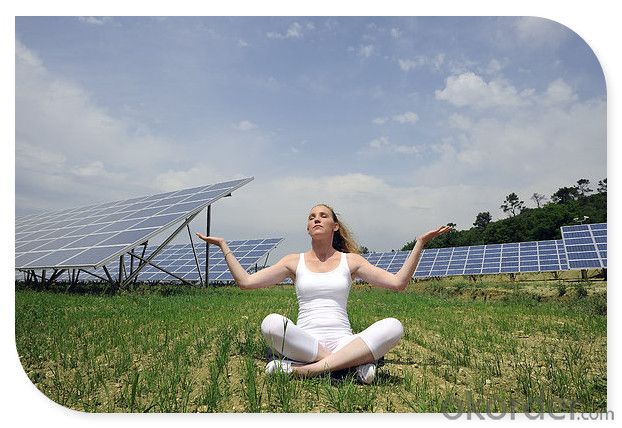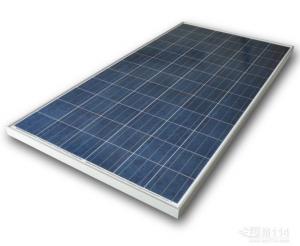Renogy Suitcase Solar Panels 295w Direct Factory Sale Price 260-300watt Solar Panels
- Loading Port:
- China main port
- Payment Terms:
- TT OR LC
- Min Order Qty:
- 10000 watt
- Supply Capability:
- 100000 watt/month
OKorder Service Pledge
OKorder Financial Service
You Might Also Like
Specification



Solar Module Introduction
Solar modules use light energy (photons) from the sun to generate electricity through the photovoltaic effect. The majority of modules use wafer-based crystalline silicon cells or thin-film cells based on cadmium telluride or silicon. The structural (load carrying) member of a module can either be the top layer or the back layer. Cells must also be protected from mechanical damage and moisture. Most solar modules are rigid, but semi-flexible ones are available, based on thin-film cells. These early solar modules were first used in space in 1958.
Electrical connections are made in series to achieve a desired output voltage and/or in parallel to provide a desired current capability. The conducting wires that take the current off the modules may contain silver, copper or other non-magnetic conductive transition metals. The cells must be connected electrically to one another and to the rest of the system. Externally, popular terrestrial usage photovoltaic modules use MC3 (older) or MC4 connectors to facilitate easy weatherproof connections to the rest of the system.
Specification
Model Type | |
Peak Power-Pmax(W) | 5-200W |
Open Circuit Voltage-Voc(V) | 44.2 |
Maximum Power Voltage-Vmp(V) | 36 |
Short Circuit Current-Isc(A) | 5.4 |
Maximum Power Current-Imp(A) | 5 |
Maximum System Voltage | 1000V DC |
Maximum Series Fuse Rating | 10A |
Power Tolerance | -1~+3% |
Temperature Coefficients of Pmax | -0.45%/℃ |
Temperature Coefficients of Voc | -0.348%/℃ |
Temperature Coefficients of Isc | 0.031%/℃ |
Nominal Operating Cell Temperature | 44.5±2℃ |
Standard Testing Condition(STC) | Irradiance:1000W/m²;Temperature:25℃;AM=1.5 |
Qualification Test Parameters | |
Operating Temperature | -40℃~+85℃ |
Storage Temperature | -40℃~+85℃ |
Pressure Bearing | ≥5400Pascal/m² |
Wind Bearing | ≥5400Pascal/m² |
Mechanical Characteristics | |
Cell Size | Mono 125*125mm±0.5 |
No.of Cells | 72pcs(6*12) |
Dimension | 1580*808*40mm |
Weight | 15.5Kg |
Glass | 3.2mm High Transmission,Low Iron |
Frame | Anodized Aluminum Alloy |
Junction Box | IP65Rated |
Internal Diodes | 3 Bypass Diodes |
Cable | 1*4.0mm² Length 900mm |
Images
Packing & Shipping:
We have rich experience on how to pack the panels to make sure the safety on shipment when it arrives at the destination.
The normal size is packed by 25pcs/ carton / pallet. Paper carton for FCL shipping and wood carton for LCL shipping.
Features
1.High reliability with guaranteed -3% to +5% power output tolerance, ensuring return on investment
2.High conversion efficiency based on leading innovative photovoltaic technologies
3.Withstands high wind-pressure and snow load, and extreme temperature variations
4.Attractive appearanceUnique frame design, high mechanical strength, and easy Installation
Warranty:
For c-Si panel: 25years output warranty for no less than 80% of performance, 10 years output warranty for no less than 90% of performance. Free from material and workmanship defects within 5 years.
For a-Si panel: 20 years output warranty for no less than 80% of performance, 10 years output warranty for no less than 90% of performance. Free from material and workmanship defects within 2 years.
•100% product quality protection
•100% on-time shipment protection
•100% payment protection for your covered amount
FAQ:
(1)What price for each watt?
It depends on the quantity, delivery date and payment terms.
(2)What is your size for each module? Can you tell me the Parameter of your module?
We have different series of panels in different output, both c-Si and a-Si. Please take the specification sheet for your reference.
(3)Can you provide the peripheral products of the solar panels, such as the battery, controller, and inverter? If so, can you tell me how do they match each other?
Actually we are only manufacturer of solar panels, but we could try to source them for you in China if you need. We could provide you an optimal system design to instruct you how to install.
(4)Do you have the CE, TUV, UL Certification?
We’ve already passed all the tests, and any certificate is available.
(5)Have you ever sold your products to companies in my country?
Of course, we have customers in all general PV markets, but I think we should expand our market share along with the market growth.
(6)When did your company set up? You are a new company, how can I believe your quality?
We entered into Solar PV industry in 2005, now we have several plants in manufacturing of a-Si and c-Si panels, and our capacity is 220MW per year. Till now we have already passed all the tests by authorized laboratories, e.g. TUV, VDE, UL.
(7)Can you help us install the module if we cooperate with you?
We haven’t entered into installation sector, but we have the plan in near future.
(8) How do you pack your products?
We have rich experience on how to pack the panels to make sure the safety on shipment when it arrives at the destination.
(9) Can you do OEM for us?
Yes, we can.
(10)Can we visit your factory?
Surely, I will arrange the trip basing on your business schedule.
- Q: Can solar panels be installed on fences?
- Yes, solar panels can be installed on fences. In fact, fence-mounted solar panels are becoming increasingly popular as they provide an additional space-efficient solution for generating renewable energy.
- Q: Can solar panels be installed on a landfill or waste management site?
- Yes, solar panels can be installed on a landfill or waste management site. In fact, landfills and waste management sites can provide suitable locations for solar installations due to their large available space and minimal shading. Additionally, installing solar panels on these sites can help utilize otherwise unused land while also providing renewable energy generation and reducing greenhouse gas emissions.
- Q: How do solar panel power systems work?
- Solar power works by making solar cells of two kinds of glass; one which has been “doped” to have too many electrons, and the other which has been “doped” to have too few electrons. These layers of glass are then glued together with a thin insulation layer in between them. The top layer of glass is the one with too many electrons, the bottom layer of glass has too few electrons, and the insulation allows electrons to pass from the bottom layer to the top layer easily, but not from the top layer to the bottom layer as easily. As photons come flying into this glass sandwich at the speed of light, the photons crash into the electrons in both layers and cause them to start moving. The electrons in the top layer are tightly packed and can’t move much, but the electrons in the bottom layer can move around enough that they end up crossing through the insulation into the top layer. However, because there are already too many electrons in the top layer, the newly arrived electrons have no place to rest. This buildup of electrons creates an “electrical pressure”. Then contacts are glued to the glass top and bottom, and a wire is added to connect the top layer to the bottom, and the electrical pressure which has built up in the top layer now has a way to escape, and the extra electrons which crossed over the bottom to the top can now return to the bottom layer. This flow of electrons from the top layer to the bottom layer is the electricity generated by the solar cell. A solar “panel” is made up of many of these cells wired in series to increase the voltage to make it high enough to do some useful work, such as charging batteries, and many of these panels can be wired together to do such things as supplying power to a building, or even supplying power to the utility grid.
- Q: i am wanting to build a small tiny house running 3-4 2 volt 5 watt light bulbs for a lighting source and using a Koolatron Fun Kool 26 Quart 2V Portable Mini Fridge This cooler consumes 4.5 amps at 2 volts. The conversion is: 4.5 amps (X) times 2 volts (=) equals 54 watts. and i want a solar system that will have back up for 2 days with the lights on for probly 5-6 hours a day so theirs no room for error
- you silly ! with Solar there is always room for error . you have to build it in to your numbers . solar is full of errors . So you should plan on producing at 3 times what you expect you will need . then you have enough .
- Q: How does Solar Panel make Electricity ?
- Build okorder /
- Q: Do solar panels float?
- They'll float if you tie enough hundred dollar bills to them.
- Q: Can solar panels be installed on commercial buildings?
- Yes, solar panels can be installed on commercial buildings. In fact, many businesses and organizations are increasingly opting for solar panel installations to reduce their energy costs and environmental impact. By harnessing sunlight and converting it into electricity, solar panels provide a sustainable and renewable source of power for commercial operations.
- Q: Are solar panels safe for the environment?
- Yes, solar panels are safe for the environment. They generate electricity using sunlight, which is a renewable and clean energy source. Solar panels produce no greenhouse gas emissions, air pollution, or waste materials during operation. Additionally, they do not deplete natural resources, as sunlight is an abundant and infinite source of energy.
- Q: i have a 50 watt 2 Volt solar panel..Will it can switch on directly a car head light on a sunny day??? How much head lights it can support on a bright sunny day??? if its cloudy then can it run a single Head light???? i have no batteries just want to connect a car Head light directly to solar panel.
- It should illuminate two auto headlights on a sunny day, if it really generates 50 watts at 2 V. On a cloudy day, I don't know. It depends on how cloudy it is.
Send your message to us
Renogy Suitcase Solar Panels 295w Direct Factory Sale Price 260-300watt Solar Panels
- Loading Port:
- China main port
- Payment Terms:
- TT OR LC
- Min Order Qty:
- 10000 watt
- Supply Capability:
- 100000 watt/month
OKorder Service Pledge
OKorder Financial Service
Similar products
Hot products
Hot Searches
Related keywords



























